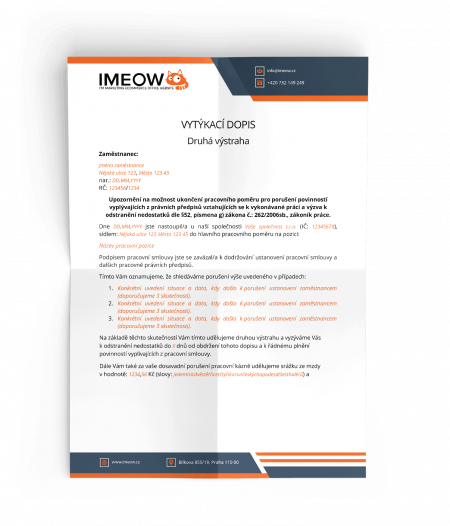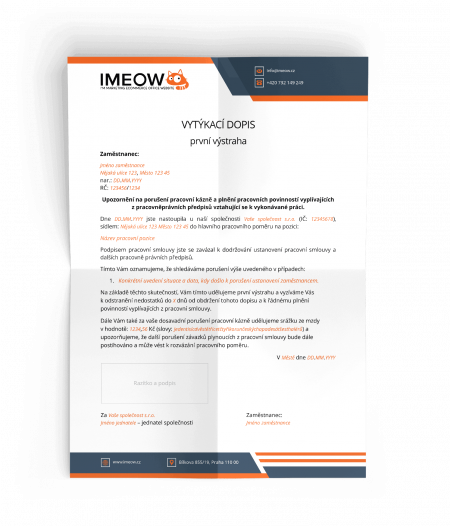This text is for informational purposes only and provides comprehensive information on the issue of terminating an employment relationship by the employer. If you have any doubts, please contact your legal representative. The operator is not responsible for any possible damages resulting from the use of the information provided. The information in the article is governed by the legal system of the Czech Republic.
As an employer, you have 4 basic options for terminating an employment relationship:
- Termination by mutual agreement (Termination by Agreement)
- Termination by the employer under § 52 (a) to (d) of the Labor Code
- Termination by the employer under § 52 (e) to (h) of the Labor Code
- Immediate termination of the employment relationship under § 55 of the Labor Code
What the law says
§ 52 Notice given by the employer
The employer can only terminate the employment of the employee for the following reasons:
- If the employer or its part is discontinued,
- If the employer or its part is relocated,
- If the employee becomes redundant due to the employer’s decision or the decision of the relevant authority to change his/her tasks, technical equipment, to reduce the number of employees in order to increase work efficiency, or for other organizational changes.
- If an employee is unable, based on a medical assessment provided by a provider of occupational health services or a decision of the relevant administrative authority that reviews the medical assessment, to continue performing their previous work due to a work-related injury, occupational disease, or the risk of such disease, or if they have reached the maximum allowable exposure at a workplace specified by a decision of the relevant public health protection authority,
- if the employee has lost, due to their medical condition according to a medical assessment provided by a provider of occupational health services or a decision of the relevant administrative authority that reviews the medical assessment, their long-term ability to work,
- if the employee does not meet the requirements set by legal regulations for performing the agreed work or if, without the employer’s fault, they do not meet the requirements for proper performance of this work; if the failure to meet these requirements results in unsatisfactory work results, the employee may be dismissed for this reason only if the employer has been requested in writing to remedy the situation in the last 12 months and the employee has not remedied it within a reasonable time,
- if there are reasons for the employer to terminate the employment relationship immediately, or for a serious breach of duty arising from legal regulations relating to the work performed by the employee; for a persistent but less serious breach of duty arising from legal regulations relating to the work performed, the employee may be given notice of termination only if they have been warned in writing within the last 6 months about the possibility of termination in connection with the breach of duty arising from legal regulations relating to the work performed,
- if the employee grossly violates any other obligation of the employee specified in § 301a.
§55 Immediate termination of employment
- The employer may exceptionally terminate the employment relationship immediately only if:
- The employee has been finally convicted of an intentional criminal offense and sentenced to unconditional imprisonment for a period longer than 1 year, or has been finally convicted of an intentional criminal offense committed while performing work duties or in direct connection with them and sentenced to unconditional imprisonment for a period of at least 6 months, or
- The employee has grossly violated an obligation arising from legal regulations relating to the work performed.
- The employer may not terminate the employment relationship immediately with a pregnant employee, an employee on maternity leave, or an employee who is on parental leave.
What does it mean for us?
Agreement on Termination of Employment (Termination by Agreement)
It is important to note at the outset of this paragraph that the Labor Code does not recognize the traditional term “Termination by Agreement”. Employment can be terminated either by the will of one of the parties (employer or employee), which is a termination, or by mutual agreement, which is an agreement. It is not possible to combine the terms agreement and termination. The key difference is that, unlike a termination, an agreement requires the consent of both parties. However, if both parties sign a “Termination by Agreement,” the document title itself does not prevent the application of the document as a whole, i.e.: the employment relationship still terminates.
Incorrect use of the Termination by Agreement
Unfortunately, employers often use this form of termination to immediately terminate employment without entitlement to severance pay, and the employee is often subjected to pressure to sign it. However, it should be emphasized that this method is completely inappropriate for problematic employees, especially due to its frequent inconsistency with the Labor Code. It is also important to mention that signing an agreement on termination of employment does not automatically waive the right to severance pay. If the reasons mentioned in §52 letters a) to d) apply, the employee is entitled to severance pay even when signing an agreement on termination of employment (according to §67 of the Labor Code), and signing an agreement on termination of employment does not automatically mean lower unemployment benefits for the employee. There is also the fact that employees may be able to prove that they signed the agreement on termination of employment under duress and it is therefore invalid.
The agreement on the termination of employment is most suitable for situations where the employee themselves has an interest in ending the employment relationship as quickly and correctly as possible, for example when transitioning to another employer.
Termination by the employer according to § 52 letters a) to c) of the Labor Code
In cases where it is necessary to dismiss an otherwise problem-free employee, we must limit ourselves to the options listed in § 52 letters a) to c). These are cases where the employee becomes redundant, for example for organizational reasons. Termination under § 52 must be handed over to the employee in writing, and apart from confirming the receipt of the termination, the employee’s signature is not required. For the reasons stated in letters a) to d), it is also necessary to take into account the notice period, which is either contractually agreed (minimum of 2 months by law, and if using the Imeow office system, the notice period is set to 3 months by default), and the employee is entitled to severance pay of 1-3 monthly salaries depending on the length of the employment relationship.
- Less than 1 year: severance pay in the amount of one average monthly salary
- 1-2 years: severance pay in the amount of two average monthly salary
- 2 years and over: severance pay in the amount of three average monthly salary
Termination by the employer pursuant to § 52 letter d) and e)
There may be situations in life when an employee loses their fitness for work in their current job. In such cases, it is necessary to address the termination of employment either according to §52 d) or §52 e). It is important to distinguish the reasons that led to the situation itself, and it depends on the decision resulting from the loss of fitness for work.
Occupational injury, occupational disease, or risk of such disease
In these cases, the employer is obliged to transfer the employee to another position. However, if such a position does not exist in the company, or there are serious reasons for not assigning the employee to this position, it is possible to dismiss the employee. The employee is entitled to severance pay according to §67 of the Labour Code, which is at least twelve times their average monthly earnings.
Other reasons for losing work capacity
However, if an employee has lost work capacity for a reason other than that stated in point d), the employer is still obliged to provide the employee with another job position. Nevertheless, if such a position does not exist or if there are other serious reasons why the employee cannot be reassigned, the employer is obliged to immediately terminate the employment relationship, and the employee’s entitlement to severance pay ceases to exist. It should be noted that the employee’s obligation to address the situation that has arisen arises immediately when the employer becomes aware of the employee’s medical assessment.
It is also necessary to properly verify that this assessment clearly indicates how the employee’s loss of work capacity occurred – see the justification of the Supreme Court of the Czech Republic from January 18, 2013, file no. 21 Cdo 492/2012 or the judgment of the Supreme Court of the Czech Republic from December 16, 2013, file no. 21 Cdo 224/2013, from which it follows that if the medical assessment does not clearly state how the employee’s loss of work capacity occurred, this assessment cannot serve as a basis for termination by the employer under §52 d) and e) of the Labor Code.
Termination by the employer under §52 letters f) and g) of the Labor Code
If we have to terminate the employment relationship with an employee who is causing you wrinkles on your forehead, we can use §52 letters f) to g), particularly:
- Failure to meet the requirements set forth by legal regulations for the performance of the agreed work or failure, not attributable to the employer, to meet the requirements for the proper performance of such work; if the failure to meet these requirements results in unsatisfactory work results.
- For a serious breach of the obligations arising from legal regulations relating to the work performed by the employee; for a sustained, less serious breach of obligations arising from legal regulations relating to the work performed.
However, in order to apply both letters of §52, it is necessary to inform the employee in advance in writing with a reprimand letter. The reprimand letter must also clearly mention the possibility of terminating the employment relationship. It is also necessary to distinguish whether it concerns unsatisfactory work results or a breach of work discipline.
Not achieving work results like other employees
In this case, we can mention reasons such as laziness, frequent mistakes, non-productivity, and overall lack of benefit for the employer. On the other hand, letter g) refers to a violation of work discipline as such. It usually involves refusing to comply with superiors, not following work procedures, or inappropriate behavior in the workplace. Incorrect differentiation of reasons for termination may also lead to subsequent invalidity of the termination.
In both cases, however, it applies that the employee had to be informed about the possibility of termination in advance. The employee is not entitled to severance pay in this case, but it is not an immediate termination of the employment relationship, but termination with a notice period. If the notice period is not specified, its duration according to the Labor Code is 2 months. (In the case of using the Imeow office system, the notice period in the default setting is 3 months.) The notice period begins to run on the first day of the calendar month following the delivery of the notice to the employee and ends on the last day of the relevant month. The only possible reasons for terminating employment without notice period are provided by §55 of the Labor Code to the employer.
Immediate termination of employment under §55 of the Labor Code
If a situation arises that requires immediate action by the employer, this possibility is addressed in §55 of the Labor Code. In the case of letter a), the situation is clear. This refers to cases where:
- The employee has been convicted of an intentional crime and sentenced to an unconditional term of imprisonment for more than 1 year, or has been convicted of an intentional crime committed while performing work duties or in direct connection with them, and sentenced to an unconditional term of imprisonment for at least 6 months.
The second and more common way to immediately terminate employment is letter b), which is:
- If an employee grossly violates an obligation arising from legal regulations related to their work.
These violations may include alcohol or drugs in the workplace, and other gross violations of work discipline. In these and similar cases, you have the option to terminate the employment relationship with immediate effect and without entitlement to severance pay.
At the end of the article, we have prepared a set of templates for you, which includes a sample termination letter for employees and two reprimand letters.

Second letter of reprimand
Second letter of reprimand (docx, CZ)Second letter of reprimand (pdf, CZ)



